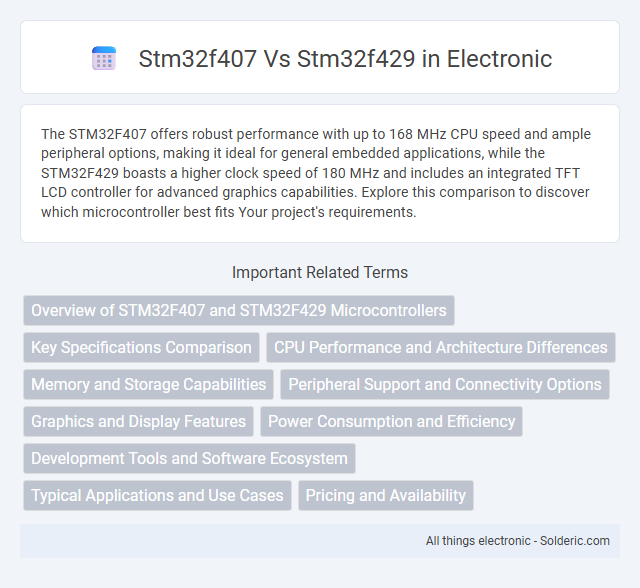The STM32F407 offers robust performance with up to 168 MHz CPU speed and ample peripheral options, making it ideal for general embedded applications, while the STM32F429 boasts a higher clock speed of 180 MHz and includes an integrated TFT LCD controller for advanced graphics capabilities. Explore this comparison to discover which microcontroller best fits Your project's requirements.
Comparison Table
| Feature | STM32F407 | STM32F429 |
|---|---|---|
| Core | Cortex-M4, 168 MHz | Cortex-M4, 180 MHz |
| Flash Memory | 1 MB | 2 MB |
| RAM | 192 KB | 256 KB |
| USB | USB OTG Full Speed + High Speed | USB OTG Full Speed + High Speed |
| LCD Controller | No | Yes, TFT LCD controller |
| DMA Channels | 16 | 16 |
| Timers | Advanced, General-purpose, Basic timers | Advanced, General-purpose, Basic timers |
| Cryptographic Acceleration | No | Yes (AES, DES, HASH) |
| Package Options | LQFP, BGA | LQFP, BGA |
| Operating Voltage | 1.8V - 3.6V | 1.8V - 3.6V |
| Application | General-purpose, moderate graphics | High-end graphics, advanced features |
Overview of STM32F407 and STM32F429 Microcontrollers
The STM32F407 and STM32F429 microcontrollers from STMicroelectronics belong to the STM32F4 series, featuring ARM Cortex-M4 cores with DSP instructions and floating-point units, optimized for performance and efficiency in embedded systems. The STM32F429 offers enhanced capabilities including higher maximum clock speeds up to 180 MHz, more memory options with up to 2 MB of Flash and 256 KB of RAM, and advanced peripherals such as a Chrom-ART Accelerator for improved graphical performance. Both MCUs support extensive connectivity interfaces like USB, CAN, and Ethernet, but the STM32F429 targets applications requiring richer multimedia, display, and user interface features, making it ideal for complex industrial, consumer electronics, and IoT devices.
Key Specifications Comparison
The STM32F429 microcontroller offers higher performance with a Cortex-M4 core running up to 180 MHz, compared to the STM32F407's 168 MHz, and includes 2 MB of Flash memory versus 1 MB in the STM32F407. Both have 192 KB of SRAM, but the STM32F429 integrates a TFT LCD controller and supports camera interfaces which the STM32F407 lacks. Peripheral sets are similar, though the STM32F429 provides enhanced graphics and multimedia capabilities for advanced embedded applications.
CPU Performance and Architecture Differences
The STM32F429 features a Cortex-M4 core running up to 180 MHz, offering higher CPU performance compared to the STM32F407's Cortex-M4 core at 168 MHz, making it suitable for more demanding applications. Your choice benefits from the STM32F429's enhanced DSP capabilities and floating-point unit, which deliver improved processing efficiency and precision in complex algorithms. Architectural differences include the STM32F429's larger memory and advanced peripherals, providing greater flexibility and speed for real-time processing tasks.
Memory and Storage Capabilities
The STM32F407 features up to 1 MB of Flash memory and 192 KB of SRAM, providing robust performance for complex applications. The STM32F429 significantly enhances storage capabilities with up to 2 MB of Flash memory and 256 KB of SRAM, allowing you to handle larger codebases and more data-intensive tasks. Both microcontrollers support external memory interfaces, but the STM32F429's increased memory capacity offers greater flexibility for demanding embedded systems.
Peripheral Support and Connectivity Options
The STM32F429 offers enhanced peripheral support compared to the STM32F407, including a higher number of GPIOs, an advanced LCD-TFT controller for display interfaces, and additional DAC channels. Connectivity options in the STM32F429 include Ethernet MAC with IEEE 1588 support and more USART interfaces, whereas the STM32F407 provides basic Ethernet and fewer communication ports. Both microcontrollers support USB OTG and CAN interfaces, but the STM32F429's expanded peripherals cater to more complex, multimedia-rich applications.
Graphics and Display Features
STM32F429 offers advanced graphics and display features with a built-in Chrom-ART accelerator, supporting TFT LCD displays up to WXGA resolution (1366x768), which enables smoother and faster rendering compared to the STM32F407. The STM32F407, while capable of driving LCDs, lacks dedicated hardware acceleration for graphics, making it less efficient for complex GUIs. Choosing STM32F429 enhances your project's display performance and graphical user interface responsiveness significantly.
Power Consumption and Efficiency
The STM32F407 operates at a lower clock speed, resulting in reduced power consumption compared to the STM32F429, which features a higher-performance ARM Cortex-M4 core with integrated DSP and FPU for demanding applications. The STM32F429 supports multiple power-saving modes, including sleep and stop modes that optimize energy efficiency during idle periods, making it suitable for power-sensitive devices requiring high processing capabilities. Your choice between these microcontrollers should consider the trade-off between the STM32F407's energy efficiency and the STM32F429's enhanced performance and multimedia features.
Development Tools and Software Ecosystem
STM32F407 and STM32F429 both support a wide range of development tools including STM32CubeMX, Keil MDK, IAR Embedded Workbench, and GCC-based toolchains, providing flexibility for various project needs. STM32F429 offers enhanced software ecosystem features with integrated LCD-TFT controllers and additional middleware libraries, making it ideal for complex graphical applications and advanced user interfaces. Your development experience benefits from STMicroelectronics' comprehensive firmware libraries and real-time operating system support, ensuring robust and scalable application design.
Typical Applications and Use Cases
The STM32F407 is widely used in industrial control, motor drives, and audio applications due to its efficient Cortex-M4 core and robust DSP capabilities. The STM32F429, with its higher clock speed, enhanced graphics support, and larger memory, is ideal for advanced human-machine interfaces (HMI), medical devices, and complex multimedia systems. If you require high performance and rich graphical features for your project, the STM32F429 provides a superior platform compared to the STM32F407.
Pricing and Availability
The STM32F407 generally offers more cost-effective pricing compared to the STM32F429, making it a preferred choice for budget-sensitive projects. Both microcontrollers are widely available through major distributors such as Digi-Key, Mouser, and Arrow, ensuring reliable supply chains. Your selection may depend on balancing cost constraints with performance needs, as the STM32F429 commands a premium due to its advanced features.
stm32f407 vs stm32f429 Infographic

 solderic.com
solderic.com